The password reset MitM attack Gelernter et al., IEEE Security and Privacy 2017
The Password Reset Man-in-the-Middle (PRMitM) attack is really very simple, but that doesn’t mean it’s not dangerous. It involves persuading the user to sign-up for an account for some service under the attacker’s control (maybe there’s an enticing free download for example), and then manipulating the registration flow such that the attacker is actually able to reset the password for the user’s account on some other system. An especially good target is the user’s email account. As we know, it’s all downhill from there. In addition to explaining the attack, and demonstrating it in user experiments with Google and Facebook users, the authors also provide a set of recommendations for implementing a password reset process to minimise the risks of PRMitM attacks.
We evaluated the PRMitM attacks on Google and Facebook users in several experiments, and found that their password reset process is vulnerable to the PRMitM attack. Other websites and some popular mobile applications are vulnerable as well… Since millions of accounts are currently vulnerable to the PRMitM attack, we also present a list of recommendations for implementing and auditing the password reset process.
The findings were reported to vulnerable vendors. Snapchat and Yahoo! fixed the vulnerability, Google, LinkedIn and Yandex indicated that they plan to fix it. Other less vulnerable websites (e.g. Facebook) indicated they would consider using the findings in the future but do not plan to apply fixes anytime soon.
I forgot my password
Sometimes users genuinely do forget their passwords, and then there needs to be a way to reset them. You can have the strongest password / authentication mechanism in the world of course, but if the password is easy to reset none of that matters. So how do you make a password reset process that’s at least as strong and secure as the regular authentication process?
If you’re using one of the ten most popular websites, here are the challenges you may be presented with during the reset process:
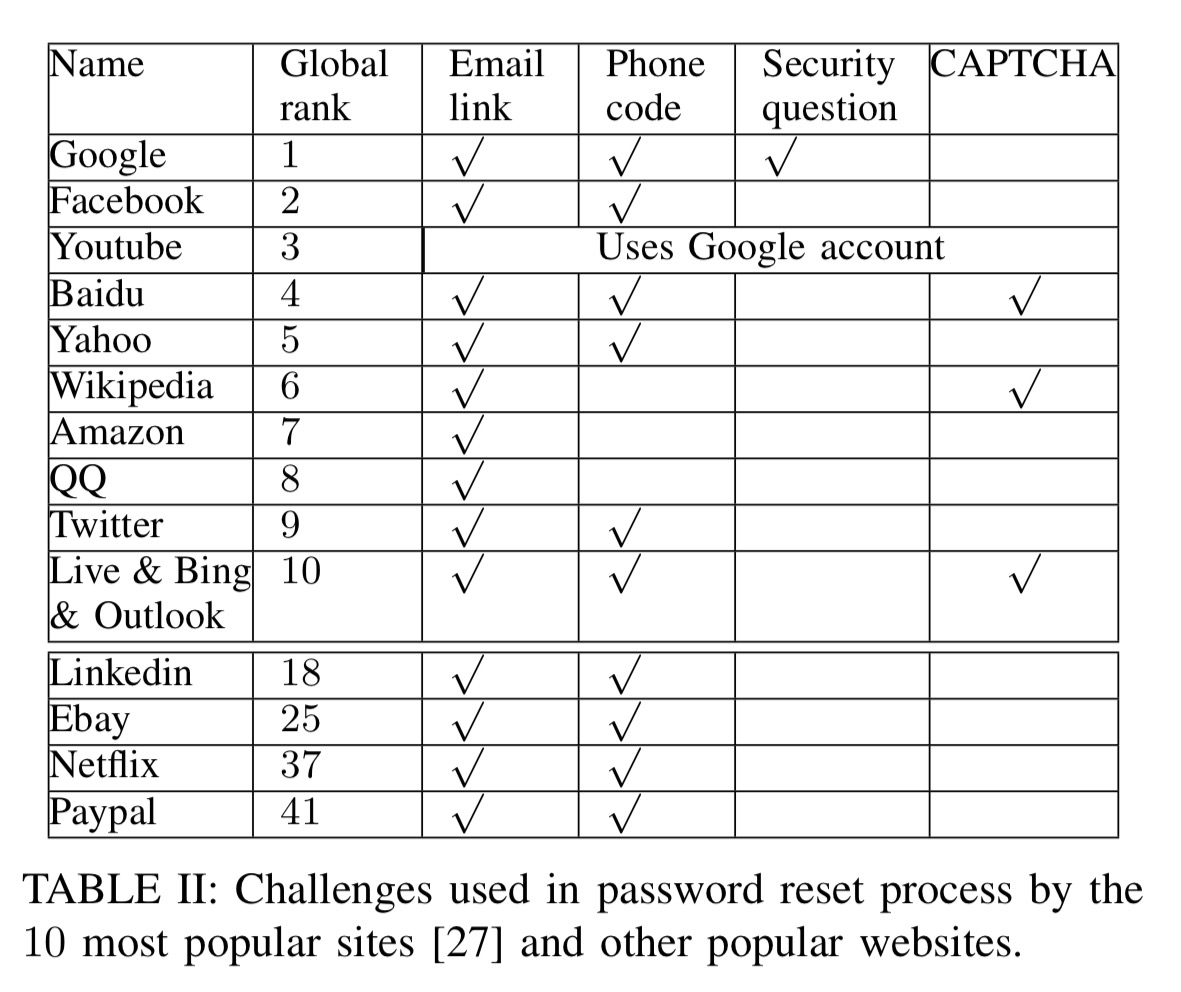
(The authors don’t discuss if/how this changes when you have two-factor authentication enabled – do many sites then require you to provide a backup code or recovery key for example? I didn’t have time to investigate all of the sites listed above).
CAPTCHAs are really only there to make it harder for attackers to automate going through the password reset process; they don’t provide any fundamental security. Security questions may relate to answers you provided during account creation, or to information you may know about your account (for example: which of these contacts is in your address book…). Phone codes refers to either a code sent to a registered phone number via SMS, or an automated call that may be placed to that number which reads you a code. The most common defense is sending a password reset link in an email, unfortunately this mechanism is usually not relevant for email accounts themselves.
Let’s be honest, bar the email link, none of these mechanisms are particularly great: security questions are known to be problematic, and SMS is wide open – weaknesses in the SS7 protocol let anyone redirect your phone calls and text messages:
“It’s so simple, it’s almost embarrassing to call it a hack” – So hey, you should stop using texts for two-factor authentication, Wired 2016.
The authors of this paper also conducted a short experiment to see whether users would give ‘correct’ answers to security questions for low-value websites (e.g. “What is your mother’s maiden name?”). Almost 80% of users in the study provided the correct answer to the security question, indicating the problem of relying on security questions. You could make up answers of course, but then you’ll need a way of remembering those answers when you’ve forgotten your password…
The problems with security questions and the popularity of mobile phones has made the authentication using mobile devices a preferred option for password recovery. The most common way to authenticate a user via mobile phone is by sending a code to the device. The user then has to insert the received code into the website to reset the password.
Spear-phishing attacks have been targeting the SMS codes sent during password reset for at least a couple of years (see “Password recovery scam tricks users into handing over email account access“). If that spear-phishing attack isn’t quite subtle enough to dupe enough users, and hijacking SMS via SS7 seems like a bit of a hassle, then there’s always the PRMitM attack.
The basic PRMitM attack
Phishing attacks exploit the users; there is no bug in the design of the attacked website and the attacker exploits unwary users who ignore indications given to them by the browsers. On the other hand, PRMitM attacks exploit bugs in the design of the password-reset process.
The fundamental insight behind a PRMitM attack is that many of the challenges and steps in a typical registration process are similar to those in a password reset process. The attacker sets up a website that encourages a user to create an account. When the user registers they provide their email address, which the attacker uses to initiate a password reset process with the email provider. Every challenge sent by the email provider (e.g., security questions), is forwarded to the user and appears to be part of the registration process. The answers supplied by the user are then passed on the email provider as part of the password reset flow.
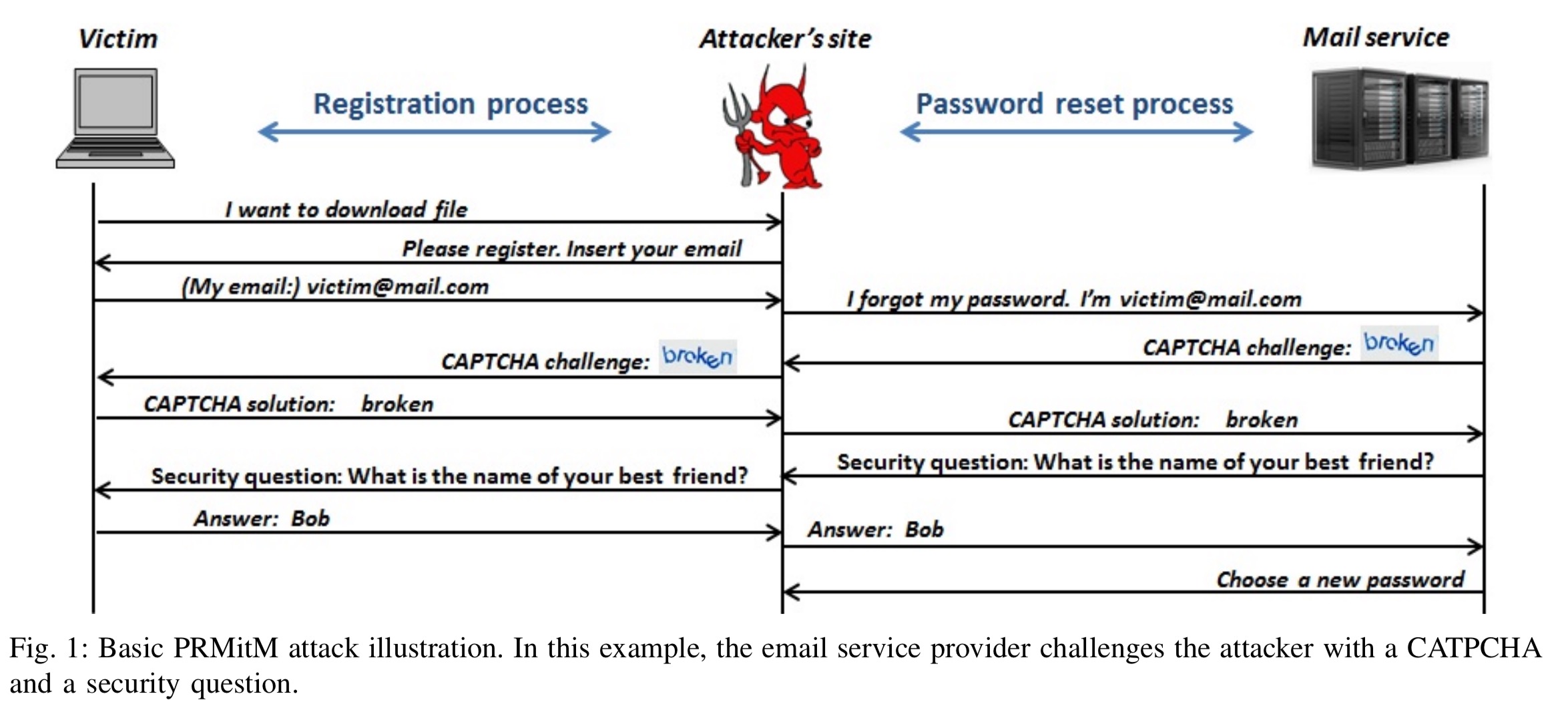
It’s easy to see how that works with security questions, but what about SMS codes? As part of the fake registration process, the attacker asks the victim for their phone number, claiming that a code will be sent to it that must be entered to complete registration. Now as part of the password reset flow initiated by the attacker, the email provider sends a code via SMS to the user’s phone. The user enters this code on the attacker’s website, and the attacker in turn supplies it to the email provider. A similar approach works if the email provider reads a code to the user via a phone call.
Why are users fooled??
Firstly, there’s the simple fact that users are expecting a code to be sent to them as part of a registration process they initiated, so when a code arrives it is not surprising. Ideally at least 3 pieces of information should appear in the SMS message sent by a provider in addition to the code (i) the name of the sending website, (ii) an explanation that the code is for password reset, and (iii) a warning to avoid using the code anywhere but the sending website. None of the evaluated website’s messages included all of these elements:
- Yandex, Google, and Yahoo in Russian send just a code
- LinkedIn, Google and Yahoo (other languages) send website name and code, but no indication it is for password reset
- Facebook, Twitter, and Microsoft include website, code, and purpose (password reset)
- None of the tested sites include a warning about not entering the code anywhere else.
Even if the SMS did have all of these elements, the authors found that many users don’t even read the text or even open the message, but just quickly grab the code from the notification that pops up on the phone.
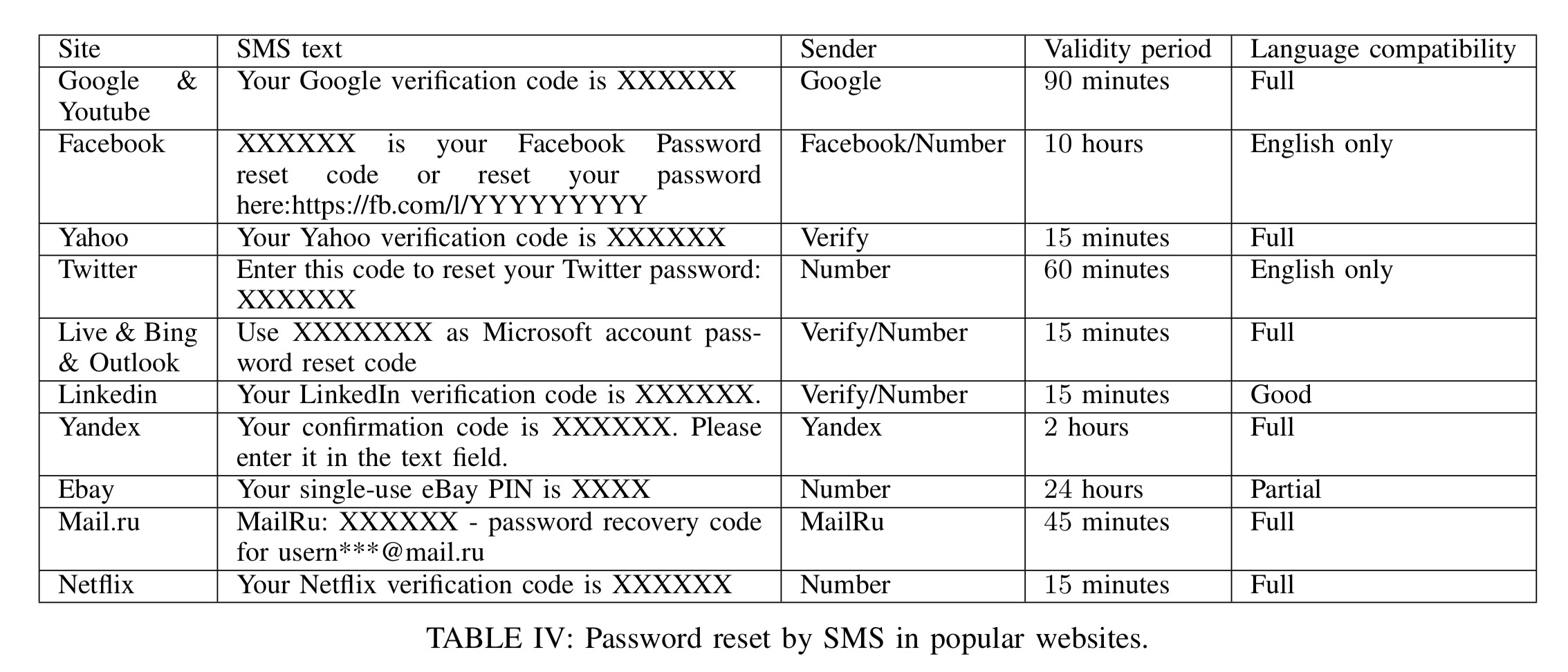
In a series of experiments run by the authors using a PRMitM attack against their Facebook accounts, most ‘victims’ (they weren’t actually hacked, but the researchers demonstrated they could) remained completely unaware that they had been hacked. The same thing happened with phone call based verifications when running PRMitM attacks against Google accounts.
If you look at messaging applications, you find similar vulnerabilities in their password reset mechanisms too:

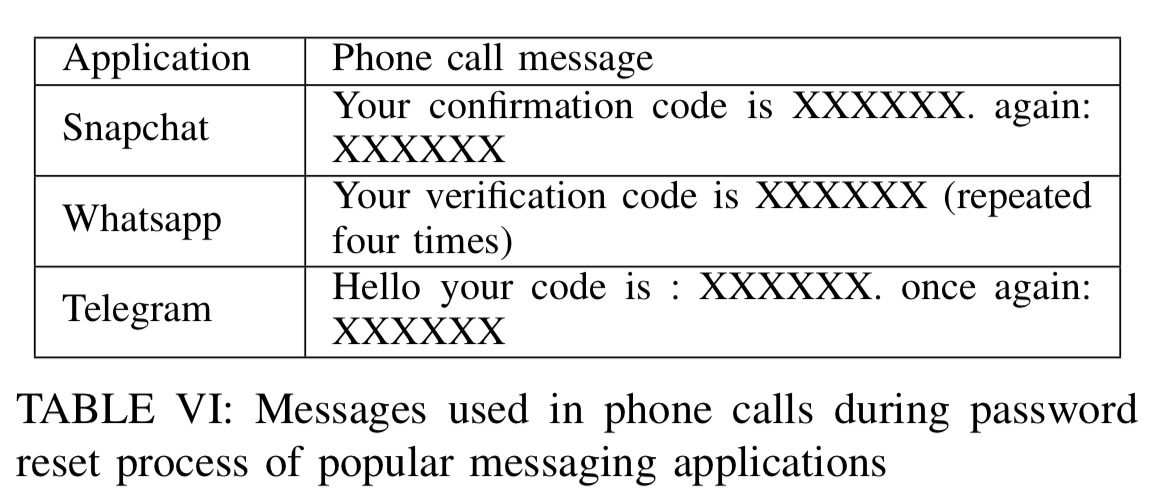
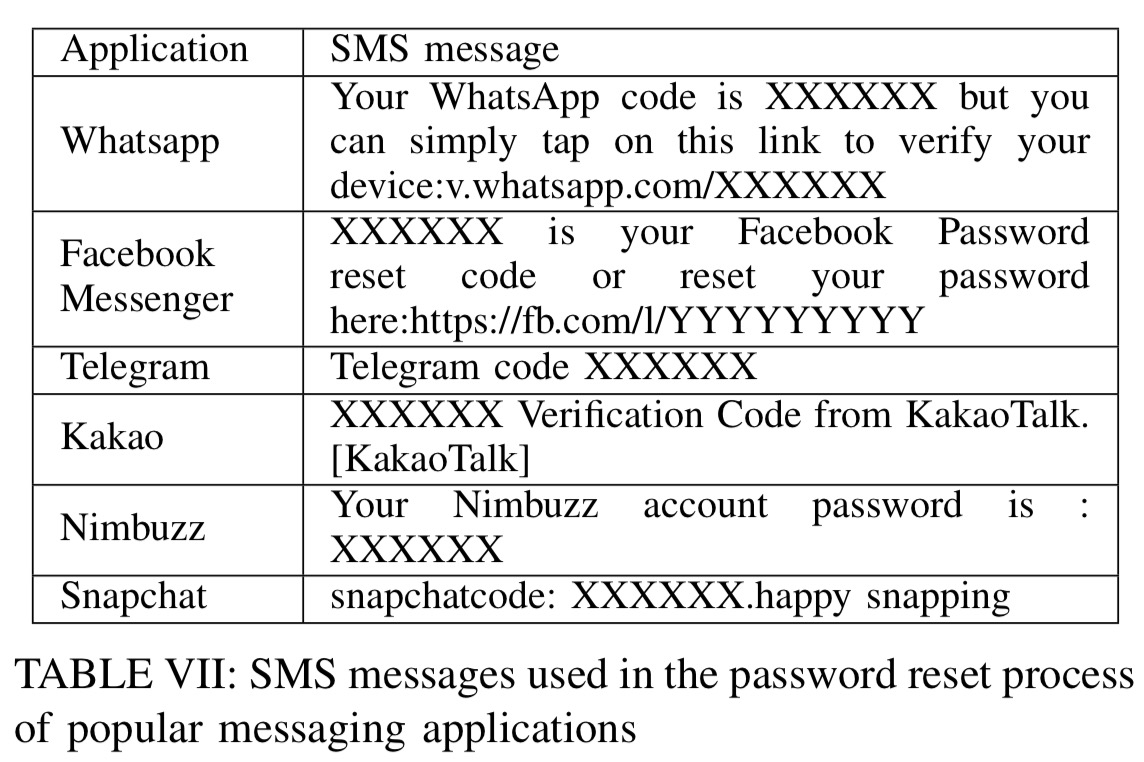
Defences and guidelines
If using security questions, if these are directly related to the actions done by the user on the site (for example, Google asks questions about contacts, labels, and so on) these can’t be forwarded to users as legitimate security questions for other sites.
Nevertheless, it is desirable to avoid relying on security questions, as they can be bypassed by attackers, especially if the attacker is related to the victim.
Better is not to send a code in clear text over SMS (and even better in my mind is not to use SMS, due to its vulnerabilities, but leaving that aside…), but instead to send a link via SMS. Asking a victim to copy and paste a link from an SMS into their website would certainly look like an unnatural act. The authors call this scheme Link-via-SMS (LVS) based password reset.
A long link is better than just a long code. The natural user interaction with links is to press on them. On the other hand, there is always a chance that a user will just copy the code without reading the message. In our implementation of the LVS, the link refers the user to an interactive page that has an alert about the attempt to reset the user password.
In tests, using the LVS approach caused all participants in the study to detect and thwart the PRMitM attack.
Websites should also always send a notification after both password reset and psasword change – via both email and SMS. Of the websites tested, only Google sends an SMS notification on password change.
In section IX of the paper you’ll find a quick checklist that can be used to audit and secure password reset procedures. If you must use SMS etc., these are worth checking out. I’ll leave you with the following reminder though:
Finally, although the recommendations of this section are given mainly in the perspective of the PRMitM attack, it is important to note that according to the NIST Digital Authentication Guideliness, due to other security problems it is not recommended to rely only on SMS or phone calls for authentication.
As I understand it, 2 factor doesn’t change the password reset. So you still get your new password via email, but you still can’t login until you provide your code.
Hi Adrian,
I am a regular reader of your log, and reading your reviews has raised my knowledge about IT tremendously. I see you read and cover a lot of publications related to systems security. To supplement your commendable work, I would like to bring to your attention publications of Clémentine Maurice. She’s done her PhD in informations security, and her publications revolve around microarchitectural covert and side channels in commodity computers and servers, reverse-engineering processor parts, and virtualization security. Her hacks into ARM processors should be considered mother of all hacks. Something like rowhammer.
Thought you would love to have a look.
Many thanks for the heads-up, I will definitely take a look! Regards, A.
Thanks for your interest, Adrian. I have 5 of her publications in my Google Drive. Would you like me to share them with you?